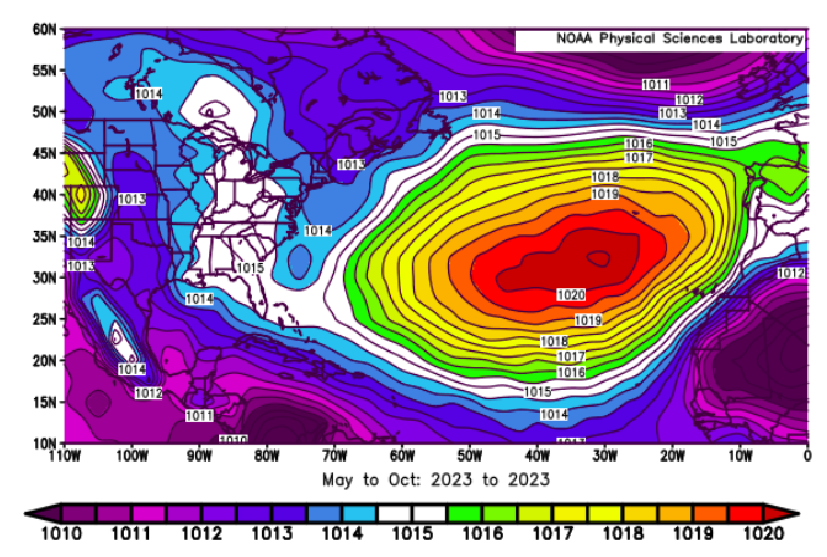State of the climate in Cuba 2023. Extended summary.
Main Article Content
Abstract
This report analyzes the main indicators that characterize Cuba's climate as well as some factors that regulate its variability in the region. Also included are some of the extreme weather and climate phenomena that have a high impact in Cuba. Variables such as temperature and rainfall are particularly important. As the main climate modulating factor, although it is not the only one, the behavior of the El Niño - Southern Oscillation (ENSO) event during 2023 is included. All information is referred to the standard climatological normal from 1991 to 2020, making it possible to compare recent or current observations as well as calculate the deviations or anomalies of a value with respect to that reference value. However, sometimes the period 1961-1990 is used, recommended by the WMO (2017) to evaluate long-term temperature changes, and in the case of bioclimatic conditions, the historical periods 1981-2010 was used.
Downloads
Article Details

This work is licensed under a Creative Commons Attribution-NonCommercial 4.0 International License.
Those authors who have publications with this journal accept the following terms of the License Attribution-NonCommercial 4.0 International (CC BY-NC 4.0):
You are free to:
- Share — copy and redistribute the material in any medium or format
- Adapt — remix, transform, and build upon the material
The licensor cannot revoke these freedoms as long as you follow the license terms.
Under the following terms:
- Attribution — You must give appropriate credit, provide a link to the license, and indicate if changes were made. You may do so in any reasonable manner, but not in any way that suggests the licensor endorses you or your use.
- NonCommercial — You may not use the material for commercial purposes.
- No additional restrictions — You may not apply legal terms or technological measures that legally restrict others from doing anything the license permits.
The journal is not responsible for the opinions and concepts expressed in the works, they are the sole responsibility of the authors. The Editor, with the assistance of the Editorial Committee, reserves the right to suggest or request advisable or necessary modifications. They are accepted to publish original scientific papers, research results of interest that have not been published or sent to another journal for the same purpose.
The mention of trademarks of equipment, instruments or specific materials is for identification purposes, and there is no promotional commitment in relation to them, neither by the authors nor by the publisher.
References
Barcia-Sardiñas, S.; Hernández-González, D.; Velázquez Zaldívar, B. & Armas-Forteza, O. 2020. Comportamiento de las condiciones de calor o frío intenso para Cuba capaces de producir efectos meteoro-trópicos peligrosos sobre la población vulnerable. (ser. Proyecto: Efectos meteoro-trópicos peligrosos asociados a las sensaciones térmicas extremas en Cuba.), Informe de Resultado Científico, no. 3, Instituto de Meteorología, 76 p.
Cangialosi, J., P., y Alaka, L. (2024). HURRICANE IDALIA (AL102023) (p. 47). Miami, USA: National Hurricane Center. Available https://www.nhc.noaa.gov/data/tcr/AL102023_Idalia.pdf (Consulted, Feb. 15, 2024)
Guevara, A. V.; Santana, M.; León, A.; Paz, L. R. & Campos, A. 2009. “Las condiciones de calor intenso (CCI) como indicador de extremos bioclimaticos en la Habana, Cuba”. Territorium, (16): 37–48, ISSN: 1647-7723, 0872-8941, DOI: 10.14195/1647-7723_16_4.
Hidalgo, A., Mitrani, I., y Pérez, G. (2023). Detección de cambios en la altura de la ola significativa en las costas cubanas. Revista Cubana de Meteorología, 29(3), 1-11.
IPCC, 2023: Summary for Policymakers. In: Climate Change 2023: Synthesis Report. Contribution of Working Groups I, II and III to the Sixth Assessment Report of the Intergovernmental Panel on Climate Change [Core Writing Team, H. Lee and J. Romero (eds.)]. IPCC, Geneva, Switzerland, pp. 1-34, doi: 10.59327/IPCC/AR6-9789291691647.001
Morim, J., et al. (2021). Global-scale changes to extreme ocean wave events due to anthropogenic warming. Environmental Research Letters, 16(7), 074056-0740565. https://doi.org/10.1088/1748-9326/ac1013
OMM, Organización Meteorológica Mundial, 2017: “Directrices de la Organización Meteorológica Mundial sobre el cálculo de las normales climáticas (OMM-Nº 1203)”, Genebra, Suiza.
Velázquez-Zaldívar, B.; Guevara-Velazco, A. V.; Hernández-González, D. & Armas-Forteza, O. 2020. “La Condición de Frío Intenso: nuevo indicador de extremos bioclimáticos por frío para Cuba”. Revista Cubana de Meteorología, 26(sp): 11, ISSN: 2664-0880.

